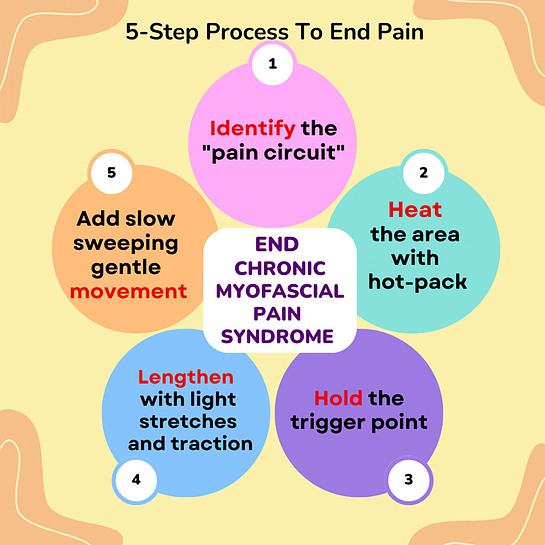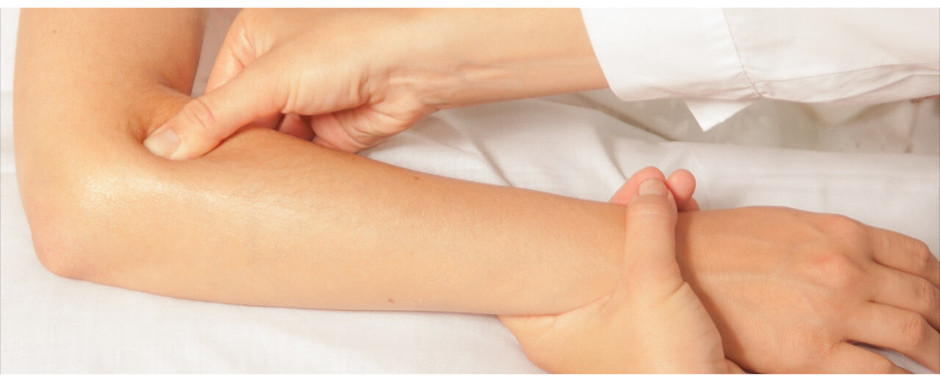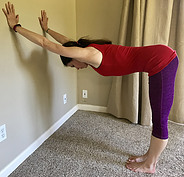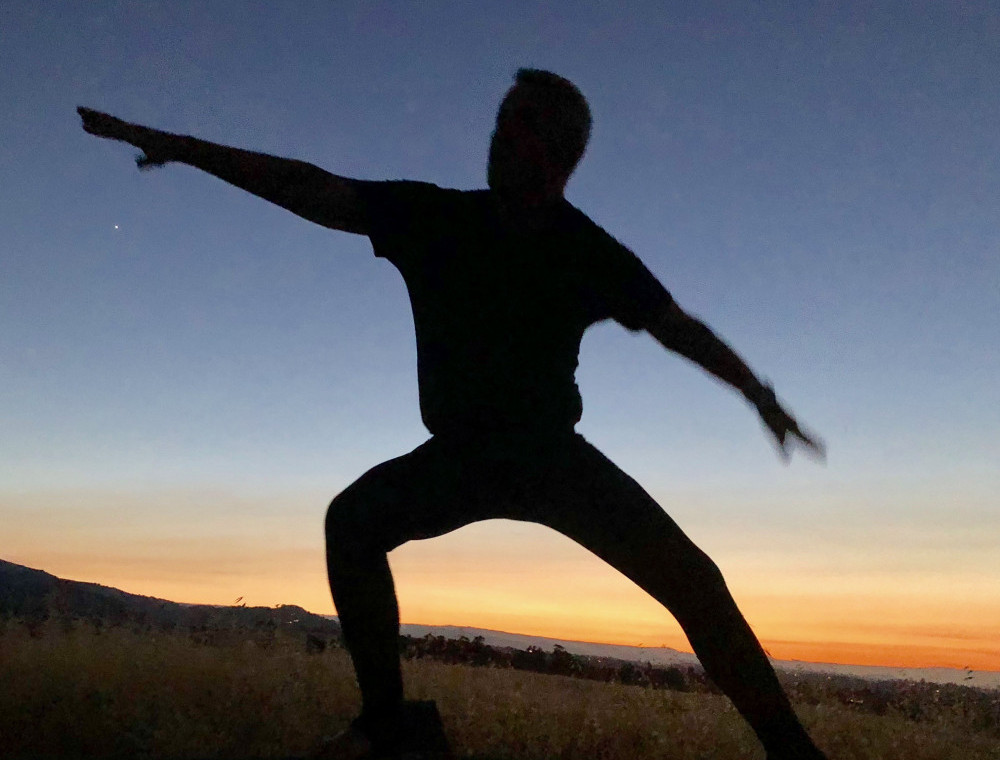Introduction
Chronic myofascial pain syndrome (MPS) can be a debilitating condition characterized by persistent muscle pain, trigger points, and restricted range of motion. While various treatment approaches exist, a five-step process has emerged to manage this condition effectively.
I developed and successfully implemented this process at my Qiworks clinic. The approach aims to identify the pain circuit, provide heat therapy, address trigger points, lengthen the fascia, and perform gentle sweeping movements. This article will delve into each step of the process, outlining its significance and potential benefits in managing chronic myofascial pain syndrome.
Step 1: Identify the pain circuit
The first step in this process involves identifying the pain circuit. Understanding the specific areas and trigger points involved in MPS is crucial for targeted treatment. By thoroughly assessing the patient, the healthcare professional can pinpoint the trigger points and design a personalized plan to address them effectively. Identifying the pain circuit helps direct subsequent steps and ensures a comprehensive approach to managing MPS.
Step 2: Heat therapy with hot packs
Heat therapy has long been recognized as a valuable pain relief and muscle relaxation method. Applying hot packs to the affected areas helps improve blood circulation, relax muscles, and reduce pain. Heat increases the extensibility of tissues, allowing for enhanced flexibility and improved range of motion. Employing heat therapy as the second step sets the stage for subsequent interventions to be more effective.
While Ice has been used to reduce inflammation, Myofascial Pain Syndrome is not an inflammatory response. It is a thickening of the myofascial connective tissue due to the altered state of the fibroblast into its inactive fibrocyte state. Ice will reinforce that altered state and lengthen the healing process.
Step 3: Trigger point release
Trigger points, areas of hyperirritability within muscles and their surrounding fascia, play a pivotal role in the myofascial pain syndrome. Addressing these trigger points is essential for alleviating pain and restoring normal muscle function. The third step involves locating the thickened point at the attachment to the joint and applying pressure to it for approximately 30 seconds. This technique, known as trigger point release, aims to release tension and promote pain relief. Patients may experience a reduction in localized tenderness and a decrease in referred pain following this intervention.
Step 4: Lengthening the fascia through gentle stretches
Fascial lengthening is a critical component in managing myofascial pain syndrome. In the fourth step, patients engage in gentle stretches targeting the affected areas. Holding each stretch for two minutes allows for adequate tissue elongation and relaxation. Micro-movements can be incorporated to enhance the effectiveness of the stretches, which involve small, controlled oscillations within the stretch position. This helps release tension within the fascia and promotes an improved range of motion.
Step 5: Perform slow, gentle sweeping movements
The final step of the process involves performing slow and gentle sweeping movements with the affected area. Move only to the outer edge of the comfort zone. This is a slow, measured process that requires patience and repetition.
This technique promotes blood flow, reduces muscle tension, and enhances tissue mobility. By incorporating slow, controlled movements, patients can experience increased circulation and relaxation, reducing pain and improving overall function. After completing step five, the process loops back to step four, allowing for continuous fascial lengthening and gradual improvement over time.
Conclusion:
The five-step process for managing chronic myofascial pain syndrome has successfully decreased pain and increased the range of motion for patients at the Qiworks clinic. This comprehensive approach targets the pain circuit, utilizes heat therapy, releases trigger points, lengthens the fascia through gentle stretches with micro-movements, and incorporates slow sweeping movements. By following this method, patients experience improved muscle function, reduced pain levels, and increased mobility.
It’s important to note that while this process has shown positive outcomes, chronic myofascial pain syndrome can vary in severity and complexity among individuals. Consulting with your healthcare professional who is experienced in pain management is crucial for proper diagnosis, personalized treatment plans, and ongoing support. With their expertise, patients can receive tailored interventions that complement this five-step process and enhance their overall well-being and quality of life.




Hello dear!
I have been suffering from myofascial pain for quite some time now and the only way I could find some relief was through stretching. I am glad that you have given me new ways to relieve the pain but do I have to do the process as given or just try one after the other trying to find out what works the best?
Thanks
Thanks for asking!
While the process works best together, you can try heating, followed by light stretches. It’s important that you just go to the first edge of the stretch, then hold it for about two minutes. Here you are not stretching the muscle, but lengthening the connective tissue surrounding the muscle. Stretching too far may help for a few minutes, but the fascia will thicken to protect the attachment and you’ll go back to being in pain soon after.
Then go for an easy walk after and move your arms too.
Let me know if that makes sense.
Keep on thriving!
Al
Thank you for shedding light on the topic of managing chronic myofascial pain syndrome in your informative blog post. As someone who has personally dealt with this condition, I understand the challenges and complexities involved in finding effective ways to cope with the pain and improve quality of life.
Living with chronic myofascial pain syndrome can be overwhelming, both physically and emotionally. However, through my journey, I have discovered various strategies that have helped me navigate this path towards relief.
One aspect that has made a significant difference for me is a multi-dimensional approach to treatment. It’s crucial to work closely with a knowledgeable healthcare professional who specializes in chronic pain management. Together, we explored a combination of therapies, such as physical therapy, trigger point injections, and myofascial release techniques. This comprehensive approach helped address both the symptoms and underlying causes of my condition.
Additionally, self-care practices played a vital role in managing my chronic pain. Implementing a consistent exercise routine, tailored to my capabilities and guided by a physical therapist, helped improve my strength, flexibility, and overall well-being. I also embraced relaxation techniques, such as meditation, deep breathing exercises, and mindfulness, which have been instrumental in reducing stress and promoting a sense of calm.
Support and community have played a crucial role in my journey as well. Connecting with others who share similar experiences through support groups or online communities has provided comfort, encouragement, and a space to exchange coping strategies and tips for managing day-to-day challenges. Having a support system in place has made a significant difference in navigating the emotional aspects of living with chronic pain.
Lastly, I want to emphasize the importance of patience and self-compassion throughout this journey. Managing chronic myofascial pain syndrome is often a process of trial and error, and it can take time to find the right combination of treatments and self-care practices that work for each individual. It’s essential to be kind to oneself, celebrate small victories, and maintain hope for a brighter future.
Thank you once again for shedding light on chronic myofascial pain syndrome and offering valuable insights into its management.
I have been reading up a lot about fascia and how to exercise in a way that benefits fascia release. I wonder if this will work on people over the age of 90 who are healthy, but have aches and pains. Is this due to fascia I wonder or a normal aging process?
It is amazing how important the fascia structure is in the body, and this structure is so often overlooked when doing exercises. We focus more on the big muscle groups and tend to forget that the fascia is important in connecting everything up together and it is also important to maintain fascia health.
Hi Michel!
Thanks for taking the time to read and comment on the article.
The Fibrocyte is an aged version of the fibroblast.
The Fibrocyte is an inactive state, and causes the fascia to be more brittle and this the individual is less flexible and stiffer. If at 90 the individual is active, that person can benefit from this process. It'll be more difficult and take a lot more time and effort if they are inactive. However, it would still be worth the effort!
Keep on thriving!
Hey Albert,
Thanks for sharing this comprehensive five-step process for managing chronic myofascial pain syndrome. It’s a great approach to target specific areas and address trigger points effectively. I particularly appreciate the use of heat therapy, trigger point release, gentle stretches, and slow sweeping movements. These techniques can help improve circulation, reduce muscle tension, and enhance mobility.
I’ll definitely consider incorporating them into my pain management routine. Your expertise is valuable in helping individuals like me improve muscle function, reduce pain, and enhance overall well-being.
Best regards,
Israel
This is a very helpful article on managing chronic myofascial pain syndrome. Maintaining a healthy fascia structure is so important. You mention that you have successfully used these five steps in your Qiworks clinic, but are there other places where one can go to for this treatment? Or can one ask your health professional to follow these steps for pain management?
For pain management at home, can one just do the gentle stretching and slow sweeping movements, or should it be preceded by heat treatment first? Thank you for clarifying.
Hi Line!
Thanks for taking the time to read and comment on the article.
To find someone who does this kind of work, look for someone who specializes in myofascial release.
Heat, even a quick 5 minutes, brings more blood flow to the area to help in the process of releasing the fascia. It just speeds up the process. If not available, hold the light stretches longer, about 3 min.
Keep on thriving!
This is such important work you are doing Albert and I can only imagine the sense of relief that Myofascial Pain Syndrome patients will experience upon discovering this article because the pain described in the muscles which results from pressure in a completely different area of the body can be unrelenting from the way I understand it. Your five step process of identifying and applying heat to the pain circuit, pressure to trigger points, lengthening the fascia with stretches and then doing slow, gentle movements will be a beneficial regimen for patients to acquire and they will be thankful got developed this method on your Qiworks clinic.
I am curious though ifthis method is able to make those suffering from CMPS more active again or just more comfortable?
Hi Joseph, thanks for reading and responding.
If thickening of the fascia is the issue that the individual is suffering from, this method will give them their full functionality back.
Keep on thriving!
Al